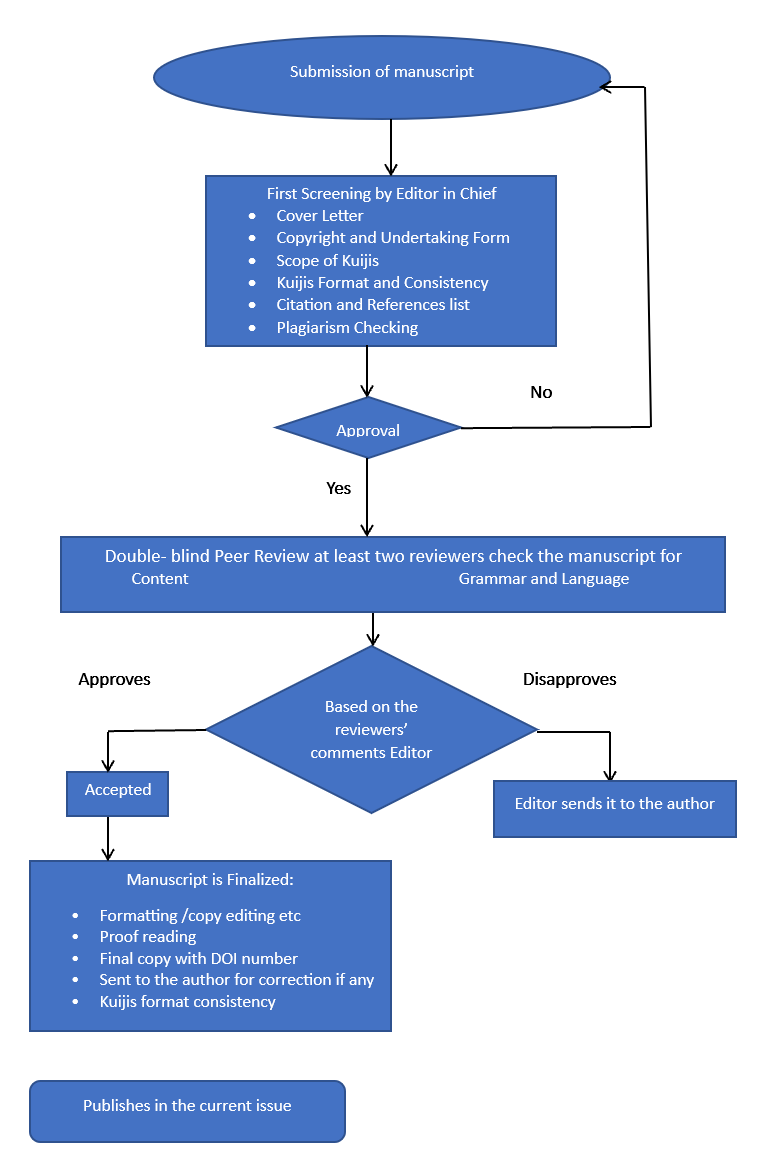About the Journal
Kunduz University Journal of Islamic Studies and Social Sciences (Kuijis) is an international peer-reviewed journal. It is published quarterly by Kunduz University. The journal welcomes submitting Original articles, Short communications, Invited review articles, and Letters to the Editor that meet the general criteria of significance and scientific excellence in all fields of Islamic studies and social sciences.
Fields of interest are Islamic culture, Jurisprudence and law, Islamic education, English language literature, Persian language and literature, Pashto language and literature, Geography, History, Psychology, Physical Education, Judicial and Prosecution, Administration and Diplomacy, National Economy and Finance and Banking.
We also accept papers on novel approaches that could advance experimental work in the above-listed areas. Within four to six weeks of submission, we want to notify authors of the initial decision on their manuscript or manuscripts.
Peer Review Process
Peer review is defined as subjecting an author’s scholarly work or research articles to the scrutiny of others who are experts in the same field. Peer review functions to encourage authors to meet the accepted high standards of their discipline and to ensure that unwarranted claims, unacceptable interpretations or personal views are not published without prior expert review. Kuijis strives to provide the fairest system of double-blind peer review and the best possible service to authors.

The Peer Review Process makes manuscripts become
- More Robust: Peer reviewers may point out gaps in your paper that require more explanation or additional experiments.
- Easier to Read: If parts of your paper are difficult to understand, reviewers can tell you so that you can fix them. After all, if an expert cannot understand what you have done, it is unlikely that a reader in a different field will understand.
- More Useful: Peer reviewers also consider the importance of your paper to others in your field and can make suggestions to improve or better highlight this to readers.
- Better Quality: Peer reviewers make sure that the manuscripts published in the journal are of the correct quality maintains the journal’s authenticity.
Key Peer Review Process stages
- Stage 1: The first stage is internal review. After submission, the chief editor conducts an initial check on content adequacy and appropriateness, format, completeness, the publication status, plagiarism, and for machine generated manuscripts. If any plagiarism is found, the manuscript is returned to author for modification.
- Stage 2: The second stage of review is the external refereeing. At this stage, the manuscript is sent to external reviewers for double blind refereeing. The referee can give feedback as publish as it is, requiring minor changes, requiring major changes. If the referee’s feedback is “publish as it is,” the paper would be published automatically. If the referee suggests any modifications or revisions in the paper, the author has to revise the paper and resubmit to journal editor. If need be, the manuscript can be sent to a different referee for consideration.
Editorial Policies
- General: In the event the required information is not provided, the manuscript will be returned to the authors for correction and this may lead to significant delays in reviewing the manuscript. All files should be prepared using a word processor (.doc, or .docx format) and not as pdf files. All text should be 12-point font size (Calibri Light) with 1.5 spaced lines and Tops = Bottom = 25,4 mm (1,0”) Left = Right = 25,4 mm (1,0”)
- Language: Manuscript should be in Arabic or English. Authors are strongly advised to ensure that the manuscript is written in clear and concise language, is intelligible to a broad readership and is of a publishable standard prior to submission. Manuscripts that are deficient in this respect may be rejected and returned to the author without peer review. To help authors avoid receiving negative comments from referees or editors about the poor use of the English language in their manuscripts, and for authors who are unsure of correct Arabic or English usage, at least one of the following steps should be considered: Have the manuscript reviewed for clarity by a colleague whose native language is English or by a colleague who has a good command of the English language.
- Proof reading: The purpose of the proof is to check for typesetting or conversion errors and the completeness and accuracy of the text, tables and figures. Substantial changes in content, e.g., new results, corrected values, title and authorship, are not allowed without the approval of the Co-Editor-in-Chief.









